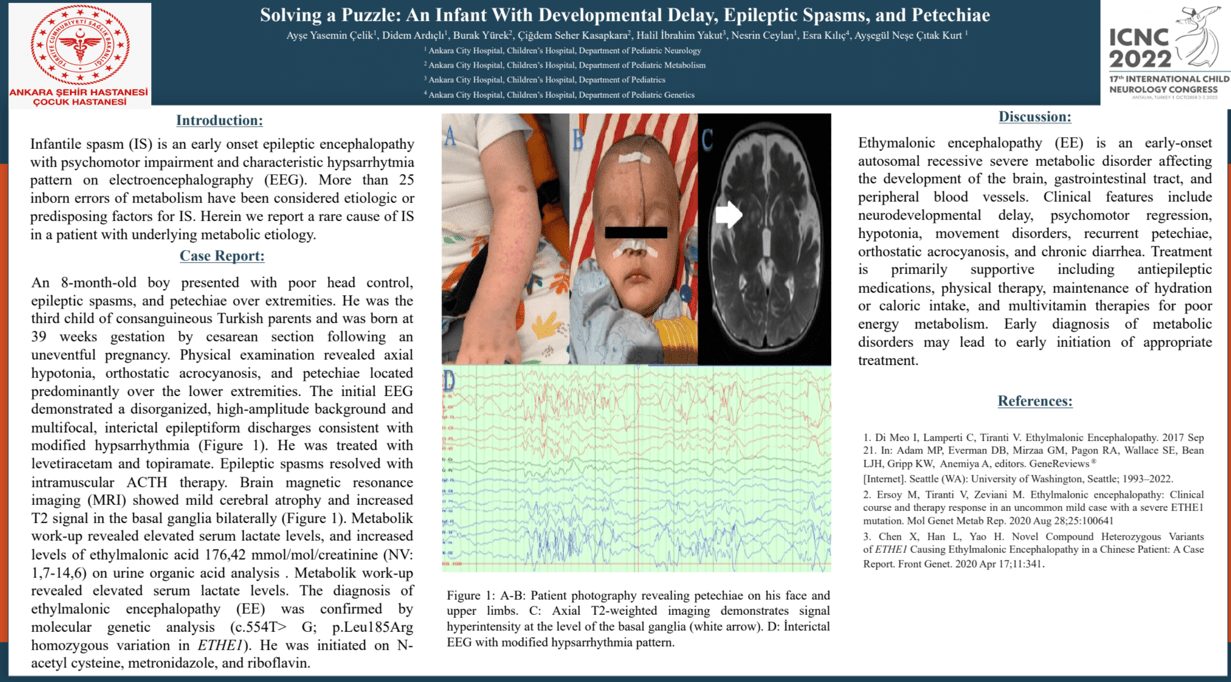Solving a puzzle: An infant with developmental delay, epileptic spasms, and petechiae
Ayse Yasemin Celik, Didem Ardicli, Burak Yürek, Ciğdem Seher Kasapkara, Halil Ibrahim Yakut, Nesrin Ceylan, Esra Kılıc, Aysegül Nese Cıtak Kurt
Objective: Infantile spasm (IS) is an early onset epileptic encephalopathy with psychomotor impairment and hypsarrhythmia pattern on electroencephalography(EEG). More than 25 inborn errors of metabolism are considered etiologic or predisposing factors for IS. Herein, we report a rare cause of IS in a patient with underlying metabolic etiology. Case presentation: An 8-month-old boy presented with poor head control, epileptic spasms, and petechiae over extremities. He was the third child of consanguineous parents, born at term following an uneventful pregnancy. Physical examination revealed axial hypotonia, orthostatic acrocyanosis, and petechiae located over the lower extremities. EEG demonstrated disorganized, high-amplitude background and multifocal epileptic discharges consistent with modified hypsarrhythmia. He was treated with levetiracetam and topiramate. Epileptic spasms resolved with intramuscular ACTH therapy. Brain magnetic resonance imaging (MRI) showed mild cerebral atrophy and increased T2 signal in the basal ganglia. Metabolik work-up revealed elevated serum lactate levels, and increased levels of ethylmalonic acid on urine organic acid analysis . The diagnosis of ethylmalonic encephalopathy (EE) was confirmed by molecular genetic analysis. She was initiated on N-acetylcysteine, metronidazole, and riboflavin. Discussion: Ethymalonic encephalopathy is an early-onset autosomal recessive, severe metabolic disorder affecting the development of the brain, gastrointestinal tract, and peripheral blood vessels. Clinical features include neurodevelopmental delay, psychomotor regression, hypotonia, movement disorders, recurrent petechiae, orthostatic acrocyanosis, and chronic diarrhea. Treatment is primarily supportive including antiepileptics, physical therapy, maintenance of hydration or caloric intake and multivitamin therapies for poor energy metabolism. Early diagnosis of metabolic disorders may lead to early initiation of appropriate treatment.
Keywords: Ethymalonic encephalopathy, petechiae, neurodevelopmental delay
Ayse Yasemin Celik
Ankara City Hospital
Turkey
Didem Ardicli
Ankara City Hospital
Turkey
Burak Yürek
Ankara City Hospital
Turkey
Ciğdem Seher Kasapkara
Ankara City Hospital
Turkey
Halil Ibrahim Yakut
Ankara City Hospital
Turkey
Nesrin Ceylan
Ankara City Hospital
Turkey
Esra Kılıc
Ankara City Hospital
Aysegül Nese Cıtak Kurt
Ankara City Hospital
Turkey
Objective: Infantile spasm (IS) is an early onset epileptic encephalopathy with psychomotor impairment and hypsarrhythmia pattern on electroencephalography(EEG). More than 25 inborn errors of metabolism are considered etiologic or predisposing factors for IS. Herein, we report a rare cause of IS in a patient with underlying metabolic etiology. Case presentation: An 8-month-old boy presented with poor head control, epileptic spasms, and petechiae over extremities. He was the third child of consanguineous parents, born at term following an uneventful pregnancy. Physical examination revealed axial hypotonia, orthostatic acrocyanosis, and petechiae located over the lower extremities. EEG demonstrated disorganized, high-amplitude background and multifocal epileptic discharges consistent with modified hypsarrhythmia. He was treated with levetiracetam and topiramate. Epileptic spasms resolved with intramuscular ACTH therapy. Brain magnetic resonance imaging (MRI) showed mild cerebral atrophy and increased T2 signal in the basal ganglia. Metabolik work-up revealed elevated serum lactate levels, and increased levels of ethylmalonic acid on urine organic acid analysis . The diagnosis of ethylmalonic encephalopathy (EE) was confirmed by molecular genetic analysis. She was initiated on N-acetylcysteine, metronidazole, and riboflavin. Discussion: Ethymalonic encephalopathy is an early-onset autosomal recessive, severe metabolic disorder affecting the development of the brain, gastrointestinal tract, and peripheral blood vessels. Clinical features include neurodevelopmental delay, psychomotor regression, hypotonia, movement disorders, recurrent petechiae, orthostatic acrocyanosis, and chronic diarrhea. Treatment is primarily supportive including antiepileptics, physical therapy, maintenance of hydration or caloric intake and multivitamin therapies for poor energy metabolism. Early diagnosis of metabolic disorders may lead to early initiation of appropriate treatment.
Keywords: Ethymalonic encephalopathy, petechiae, neurodevelopmental delay
Ayse Yasemin Celik
Ankara City Hospital
Turkey
Didem Ardicli
Ankara City Hospital
Turkey
Burak Yürek
Ankara City Hospital
Turkey
Ciğdem Seher Kasapkara
Ankara City Hospital
Turkey
Halil Ibrahim Yakut
Ankara City Hospital
Turkey
Nesrin Ceylan
Ankara City Hospital
Turkey
Esra Kılıc
Ankara City Hospital
Aysegül Nese Cıtak Kurt
Ankara City Hospital
Turkey

Ayse Yasemin Celik
Ankara City Hospital Turkey
Ankara City Hospital Turkey